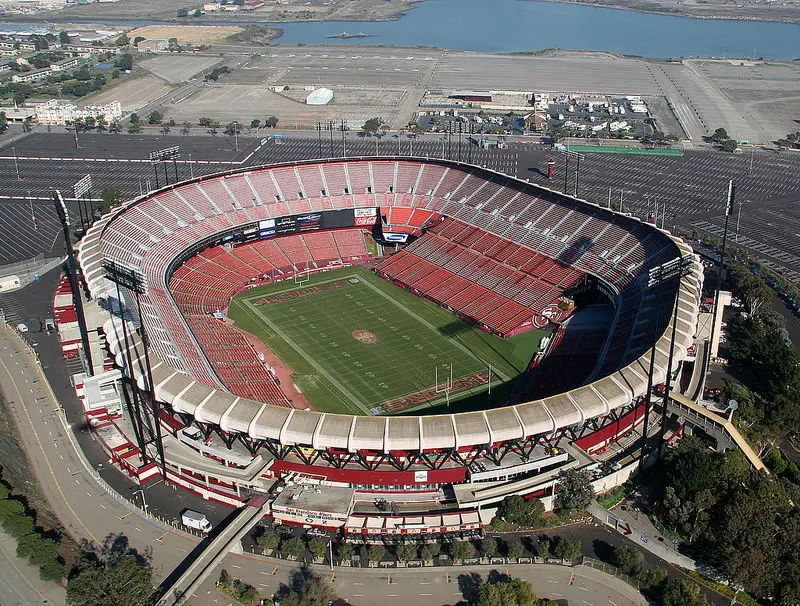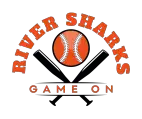Tenants: San Francisco Giants (MLB), San Francisco 49ers (NFL)
Capacity: 45,744 (original), 57,546 (final)
Surface: Grass
Cost: $15 Million, $16.1 Million & 5 Million (renovations)
Opened: April 12, 1960
Closed: September 30, 1999 (MLB)
Demolished: 2015
Dimensions: 330-L, 420-C, 330-R (original), 335-L, 400-C, 330-R (final)
History Of Candlestick Park Stadium
If you asked the Giants or 49ers fans to describe Candlestick Park in one word, you might hear words like ‘cold’, ‘blustery’, and ‘foggy’. Otherwise known as The Stick, this stadium was home to players such as Wille Mays, Barry Bonds, and Willie McCovey for 38 seasons.
The San Francisco Giants franchise was first established in 1883, on the East Coast of New York City. The team would play at four different ballparks known as the Polo Grounds until the 1950s. However, once the Polo Grounds began aging and looking structurally unsound, they began looking to relocate.
Meanwhile, in San Francisco, voters approved a $5 million bond for construction of a new stadium – on one condition. This condition was that a franchise had to move to the city to take residence in the stadium.
By the summer of 1957, Horace Stoneman, who was the majority owner of the Giants, announced that the team was moving to San Francisco. At the same time as the Giants were moving to San Francisco, the Dodgers moved from Brooklyn to Los Angeles.
The Giants played their first game in San Francisco in 1958, although it was not at their new stadium. This had still not been built by the time that the Giants moved to the city. So, they played at the Seal Stadium instead. This stadium only had a capacity of 23,000 and was considered a minor league ballpark.
Construction began at Candlestick Point in August 1958. Plenty of people had something to say about this, with lots of complaints being filed from nearby neighborhoods. A Teamster strike prevented construction from being finished so quickly and there was even a jury investigation. This pushed back the opening by an entire year.
By the mid-1970s, Horace Stoneman wanted to move the team from San Francisco because of its failure to attract fans. Stoneman even almost sold the team to a group in Toronto, but Bob Lurie bought the team in 1976 to keep them in San Francisco.
Lurie was happy to keep the Giants in San Francisco, but he wanted a new stadium built downtown. Alternatively, he wanted Candlestick Park to be domed so that the wind wouldn’t affect games so much.
Neither of these things ever happened, but $30 million was spent on adding a new scoreboard, more concession stands, and luxury suites.
Despite being demolished in 2015, Candlestick Park will go down in the record books as being one of the coldest stadiums in baseball history.

Who / What Is It Named After
Candlestick Park was named after its location – Candlestick Point. This place was named after the ‘Candlestick birds’ that populated the area for so many years. These birds are more commonly known as Long-billed curlew, which are large shorebirds that would reside near the bay.
When Did It Open
The San Francisco Giants played their first game on April 12, 1960, against the St. Louis Cardinals.
What Team Players There
Candlestick Park was the home of the San Francisco Giants from its initial opening for 38 seasons.
In 1962, discussions began about expanding Candlestick Park to accommodate the San Francisco 49ers who played in the NFL. However, this didn’t come to be true for another nine years when $16.1 million was spent to expand the stadium.
The expansion began in 1971 and ended in 1973, adding plenty of additional capacity and new features.
Location
Before the stadium was built, two locations were proposed for the new ballpark. One was downtown San Francisco, and the other was at Candlestick Point. We bet you can guess which location was chosen!
The city already owned the adjoining 31 acres, so they purchased the rest of the land for $2.7 million. Candlestick Point was right next to the bay, which is why Candlestick Park was often overcome by strong winds that would easily affect playing conditions.
Capacity (Seated & Standing)
The total capacity of Candlestick Park was 42,553. The grandstand consisted of two main seating decks, with the lower deck stretching from behind the home plate and extending to the first baseline, down to the third baseline, around the left-field foul pole, and into the left-center field.
The upper deck extended from the home plate down to the first and third baselines. There was a small section of bleachers in the right-center field.
The expansion from 1971 to 1973 brought the capacity to 59,000 to accommodate larger crowds than NFL games would be bringing in.
What Are The Stadium Dimensions
The original dimensions of Candlestick Park were as follows:
- Left: 330 feet
- Center: 420 feet
- Right: 335 feet.
By the time it was closed and demolished; however, the dimensions were as follows:
- Left: 335 feet
- Center: 400 feet
- Right: 330 feet
Seats For Sale
You can purchase seats from Candlestick Park online in pairs of two. These seats are orange and we cannot find any of the original wooden seats online to purchase. Still, these new seats are expensive enough with prices ranging from $600 to $700!
Keep a piece of baseball history in your house with a pair of these seats!
Best Seats
The best seats in Candlestick Park would be the ones located behind the home plate, either on the lower deck or the upper deck. The lower deck would give you a truer view of how the players could see the action, while the upper deck would give you more of an aerial view so that you could see more of the action.
The further away you got from the home plate, the worse your seats would be. You would see less of the action unless the ball were to land incredibly close to wherever you were sitting. However, this was often very unlikely so the seats nearest the home plate would be considered the best.
Notable Features
One of the most notable features of Candlestick Park was how the weather affected the stadium and the games played there. While sunny days were enjoyed by many at Candlestick Park, it wasn’t as enjoyable when it was super windy.
As the stadium was positioned by the bay, once the sun set it would often get very foggy and cold. Half of the seating at the stadium was set to be heated, but the piping was placed deeply into cement, causing the heating to never work properly.
The expansion that finished in 1973 saw roll-out stands being added to convert the stadium for both football and baseball games. The wooden seats were swapped out for plastic orange seats, and elevators and escalators were introduced.
A new fog horn was installed in 1994, signaling any time a Giants player would hit a home run.
Memorabilia
You can purchase a few pieces of memorabilia about this stadium, although the majority of it is prints of the stadium in its prime. There are not many of these on the market nowadays, but you can find a few being sold if you really wanted one.
Another piece of memorabilia is a Candlestick Park Stadium Baseball, with a cartoon drawing of the stadium printed over the baseball. This is a nice memento for San Francisco Giants fans who were particularly invested in Candlestick Park.
Mascot
The mascot for the San Francisco Giants is Crazy Crab, and this was the main mascot of Candlestick Park. Crazy Crab was only a mascot for 1984 and was meant to be an ‘anti-mascot’, making a mockery of the mascot craze that was going on at the time.
The Giants didn’t have another mascot until Lou Seal, who debuted in 1996. Lou Seal has seen 1,150 consecutive home games and became a popular addition to Candlestick Park.
The 49ers also had a mascot that lived at Candlestick Park – Sourdough Sam. He is considered the hardest working mascot in the NFL. Sourdough Sam is a gold miner who loves sourdough bread.
Notable Events
Due to the high wind conditions at Candlestick Park, one of the most notable events that happened here was at the 1961 All-Star Game, when Stu Miller was blown off balance by a particularly strong gust of wind.
A major earthquake shook Candlestick Park before the beginning of Game 3 of the 1989 World Series, which was set to see the Giants play the Oaklands A’s. Luckily there was no major damage done to the stadium or fans.
Other notable events include hosting two MLB All-Star Games and a World Series, along with eight NFC Championship football games, lots of other sporting events, and concerts. The Beatles’ last concert was even held at Candlestick Park in 1966.
